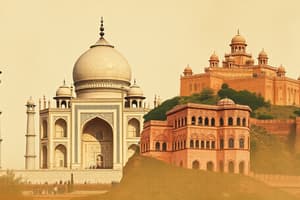Podcast
Questions and Answers
What are tangible immovable cultural properties?
What are tangible immovable cultural properties?
They are physical structures or sites of cultural heritage, including buildings, monuments, and archaeological sites that are fixed in place.
List two types of tangible immovable cultural properties and provide an example for each.
List two types of tangible immovable cultural properties and provide an example for each.
Monuments (e.g., temples) and archaeological sites (e.g., ancient cities) are two types.
Explain one challenge faced by the conservation of cultural properties.
Explain one challenge faced by the conservation of cultural properties.
Environmental threats such as weathering and climate change can damage properties.
How do tangible immovable cultural properties contribute to cultural identity?
How do tangible immovable cultural properties contribute to cultural identity?
What role do legal frameworks play in the protection of cultural heritage?
What role do legal frameworks play in the protection of cultural heritage?
Why is community involvement important in the protection of cultural heritage?
Why is community involvement important in the protection of cultural heritage?
What is the impact of urban development on tangible immovable cultural properties?
What is the impact of urban development on tangible immovable cultural properties?
Name one example of a significant tangible immovable cultural property and its importance.
Name one example of a significant tangible immovable cultural property and its importance.
Flashcards are hidden until you start studying
Study Notes
Tangible Immovable Cultural Properties
-
Definition: Physical structures or sites of cultural heritage, including buildings, monuments, and archaeological sites that are fixed in place.
-
Types:
- Monuments: Architectural works that are significant for their historical, artistic, or cultural value (e.g., temples, castles).
- Archaeological Sites: Locations with remnants of past human activity (e.g., ancient cities, burial grounds).
- Historic Districts: Areas with a concentration of historical buildings and sites that reflect a particular period or style.
-
Significance:
- Cultural Identity: Reflects the history, traditions, and values of a community or nation.
- Tourism: Attracts visitors, contributing to local economies and global cultural exchange.
- Education and Research: Provides insights into past societies, architecture, and art.
-
Conservation Challenges:
- Environmental Threats: Weathering, natural disasters, and climate change can damage properties.
- Urban Development: Expansion can lead to the destruction or alteration of sites.
- Vandalism and Neglect: Acts of vandalism and lack of maintenance can deteriorate cultural properties.
-
Protection Measures:
- Legal Frameworks: Laws and regulations at national and international levels (e.g., UNESCO World Heritage Sites).
- Conservation Practices: Strategies for restoration, preservation, and sustainable management.
- Community Involvement: Engaging local communities in the protection and promotion of cultural heritage.
-
Examples:
- Great Wall of China: A historic fortification and symbol of Chinese cultural heritage.
- Machu Picchu: An Incan citadel in Peru known for its archaeological significance and stunning location.
- Pyramids of Giza: Ancient Egyptian tombs that are key to understanding ancient civilizations.
-
International Organizations:
- UNESCO: Works to identify, protect, and preserve cultural heritage worldwide.
- ICOMOS: Focuses on the conservation of cultural heritage sites through international cooperation.
-
Best Practices in Management:
- Documentation: Recording historical significance and physical condition.
- Sustainable Tourism: Balancing visitor access with preservation needs.
- Adaptive Reuse: Repurposing buildings for new uses while maintaining their historical integrity.
Tangible Immovable Cultural Properties
- Definition: Refers to physical structures or locations representing cultural heritage, encompassing buildings, monuments, and archaeological sites that remain stationary.
Types
- Monuments: Important architectural works valued for their historical, artistic, or cultural significance, such as temples and castles.
- Archaeological Sites: Locations that contain remnants of human activity from the past, including ancient cities and burial grounds.
- Historic Districts: Areas featuring a high concentration of historical buildings that showcase a specific period or architectural style.
Significance
- Cultural Identity: Acts as a manifestation of the history, traditions, and values intrinsic to a community or nation.
- Tourism: Promotes local economies and enables global cultural interactions by attracting visitors.
- Education and Research: Offers valuable insights into past societies, their architectural advancements, and artistic expressions.
Conservation Challenges
- Environmental Threats: Properties are at risk from natural disasters, climate change, and weathering effects.
- Urban Development: The expansion of urban areas often endangers these sites through potential destruction or alteration.
- Vandalism and Neglect: Cultural properties can be damaged by vandalism and suffer from a lack of ongoing maintenance.
Protection Measures
- Legal Frameworks: Various laws and regulations at both national and international levels, such as those established by UNESCO for World Heritage Sites, help safeguard these properties.
- Conservation Practices: Involves methods for the restoration and sustainable management of cultural properties, ensuring their continued existence.
- Community Involvement: Encourages local communities to participate in the protection and promotion of their cultural heritage.
Examples
- Great Wall of China: A historic fortification recognized as a symbol of Chinese cultural heritage.
- Machu Picchu: An Incan citadel in Peru renowned for its archaeological importance and breathtaking setting.
- Pyramids of Giza: Ancient tombs crucial for understanding the history of ancient Egyptian civilization.
International Organizations
- UNESCO: Engages in the identification, protection, and conservation of cultural heritage on a global scale.
- ICOMOS: Focused on conserving cultural heritage sites through international cooperation and guidelines.
Best Practices in Management
- Documentation: Involves maintaining records of historical significance and current physical conditions of properties.
- Sustainable Tourism: Strives to find a balance between allowing visitor access and preserving the integrity of sites.
- Adaptive Reuse: Encourages the repurposing of historical buildings for contemporary uses while preserving their historical characteristics.
Studying That Suits You
Use AI to generate personalized quizzes and flashcards to suit your learning preferences.




